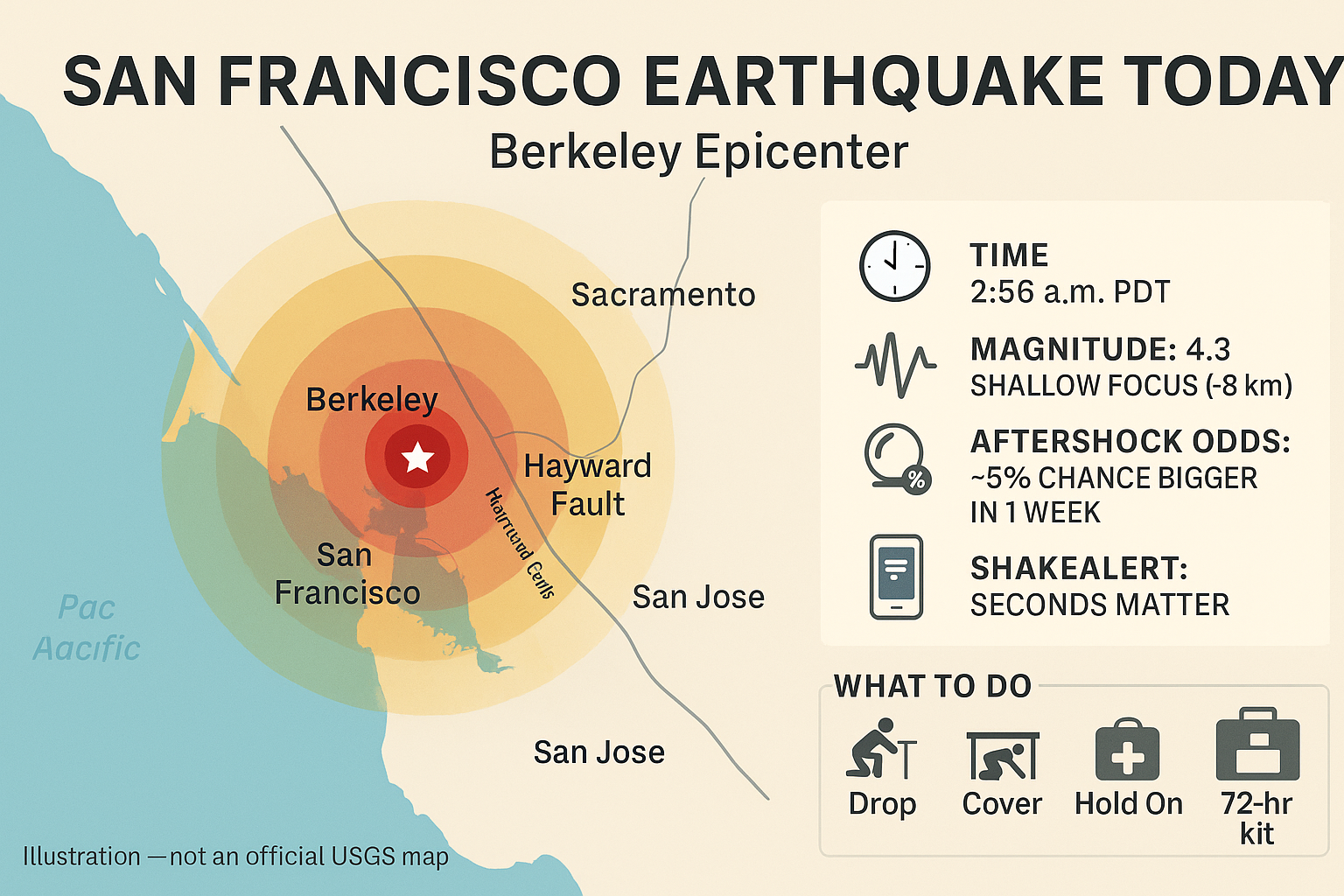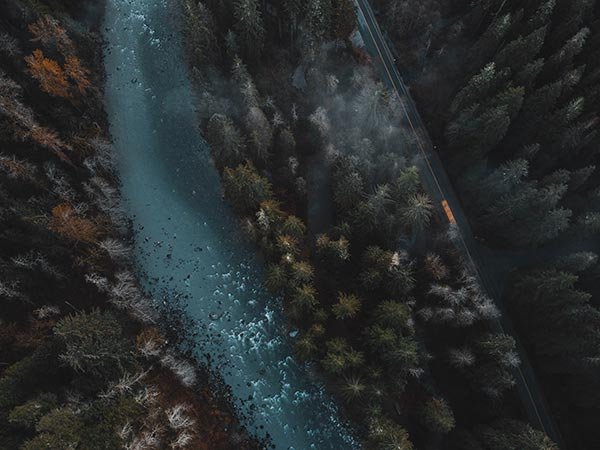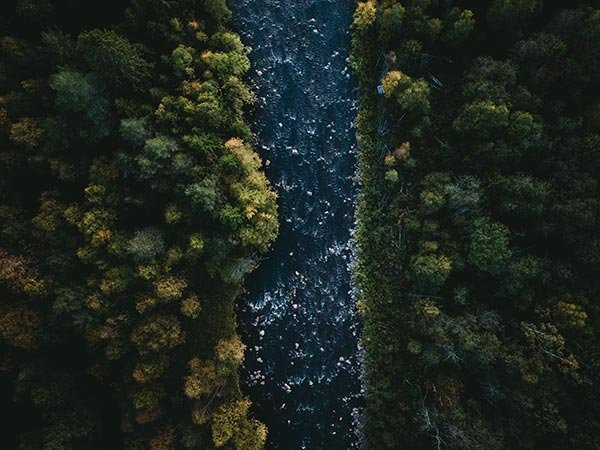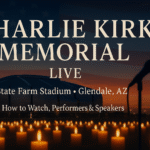San Francisco earthquake today — a magnitude 4.3 jolt near Berkeley on the Hayward Fault woke parts of SF, Oakland, Alameda, and San Jose, sending thousands to the USGS map within minutes.

At 2:56 a.m. on a too-quiet Monday, phones rattled on nightstands, pets spooked, and thousands of Bay Area residents shot upright with the same groggy thought: earthquake—near me? Within minutes, searches for “earthquake San Francisco,” “earthquake Oakland,” and “Berkeley earthquake today” spiked. The U.S. Geological Survey (USGS) revised its initial 4.6 estimate to magnitude 4.3, locating the quake just ESE of Berkeley at a depth of ~7.8 km—essentially on the doorstep of the famously restless Hayward Fault that runs under UC Berkeley’s Memorial Stadium. No major damage was reported, but the jolt was felt from Salinas to Santa Rosa and Stockton, and more than twenty thousand people filed “Did You Feel It?” reports before dawn.
To outsiders, a magnitude 4-something might sound minor. To Bay Area lifers, a middle-of-the-night snap like this one—felt strongly in Berkeley, Oakland, Alameda, and parts of San Francisco—is a visceral reminder that the region’s next truly disruptive event won’t be a traffic jam; it’ll be a fault line. As local stations and wires put it, the shake was sharp and brief, enough to knock small items and wake even heavy sleepers. Some residents got ShakeAlert notifications; others say the alert arrived as or after shaking started—typical when you’re so close to the epicenter that the seismic waves outrun the push notification.
San Francisco earthquake today: what happened and who felt it
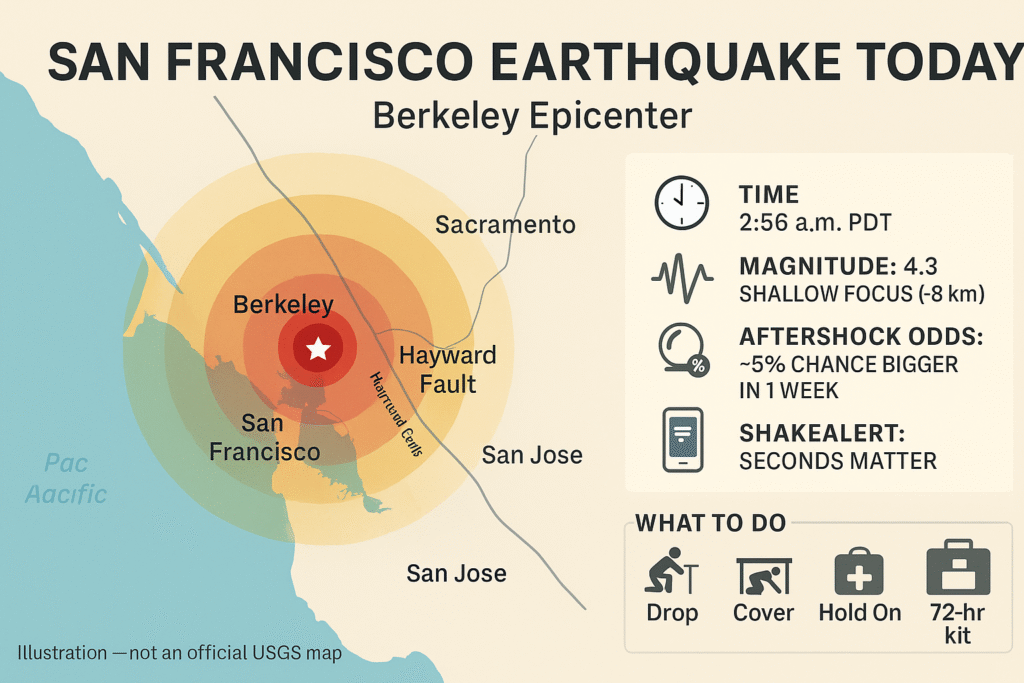
USGS’s reviewed event page lists the mainshock as M4.3, 2 km ESE of Berkeley, at 09:56:12 UTC (2:56 a.m. PDT) and about 7.8 km deep. The epicenter sits just south of campus, a few blocks from the mapped trace of the Hayward Fault—often called the Bay Area’s most urbanized fault. Early media reports carried the preliminary 4.6 figure before standard USGS reprocessing revised it to 4.3. That’s normal: as more data flows in, the magnitude is refined.
Within an hour, USGS’s “Did You Feel It?” map lit up with tens of thousands of crowd-sourced intensity reports, a real-time snapshot of how shaking varied by neighborhood—Berkeley flats versus the hills, Oakland’s different soil basins, liquefaction-prone pockets along the bay edge, and firm-rock zones that ride out waves with less amplification. SFGATE and the Chronicle both noted how broadly this temblor was felt across the Bay Area’s patchwork of soils and structures—exactly what you’d expect from a shallow East Bay quake on, or near, the Hayward system.
Berkeley epicenter, Hayward Fault risk, and Bay Area hotspots : Why Did the Magnitude Change from 4.6 to 4.3?
Two reasons. First, modern magnitude—the moment magnitude scale, not the old “Richter”—is calculated from the physics of the rupture, not a single station’s reading. As additional stations report, the algorithm revises the solution. Second, a quake’s intensity (how strong it feels in your apartment) is not the same as its magnitude (how much energy the fault released). Your kitchen might have rattled like a 6—but that’s intensity, influenced by depth, distance, soil, and building type. If you peek at a USGS ShakeMap after events like this, you can literally see the patchwork of intensities across the region. USGS Earthquake Hazards
“Is a Bigger One Coming?”—The Aftershock Odds, in Plain English
The most common—and most human—question. USGS explains it with a number you’ll hear after nearly every moderate quake: “the likelihood that an earthquake will be followed by a larger earthquake nearby and within a week is about 5%.” In other words, 19 times out of 20 the mainshock remains the main event. But that 1-in-20 chance is why officials urge caution for a few days. USGS also publishes operational aftershock forecasts that estimate the number of small aftershocks (M3+), the chance of a damaging M5+, and the odds of moderate to large follow-ons.
What We Know About the Hayward Fault (and Why East Bay Residents Obsess Over It)
UC Berkeley seismologists have called the Hayward Fault one of the riskiest urban faults in America. It slices under freeways, water mains, and dense neighborhoods from Fremont through Hayward, San Leandro, Oakland, and Berkeley. Current regional probabilities—based on USGS’s long-term models—suggest about a 33% chance of a M≥6.7 rupture on Hayward before 2043; across the broader Bay Area fault network, the chance of at least one M≥6.7 in that time span is ~72%. Those numbers aren’t posted to scare you; they’re a budgeting tool for cities and a planning nudge for households. earthquakes.berkeley.edu
If you live on bay fill, in a soft-soil basin, or in an older unretrofitted masonry building, shaking can amplify—think of bass notes booming in a concert hall compared with a quiet note in your car. That’s why a Berkeley quake can feel surprisingly punchy in pockets of Oakland, Alameda, and even parts of San Francisco along the waterfront.
How Well Did ShakeAlert Perform?
Bay Area residents shared a mix of experiences: some got a heads-up; others saw the alert after the jolt. That’s not a contradiction—it’s physics. ShakeAlert is a race between computers and seismic waves. When the epicenter is practically under your feet, there may be zero or even negative warning time; farther away, you might get several seconds. The system did activate for this event, according to official feeds. As UC Berkeley’s Richard Allen has put it: “What we’re doing with early warning is predicting the ground motion after we know the earthquake is underway.” Even a 3–10 second window can stop trains, open firehouse doors, pause surgeries, and cue “drop, cover, and hold on.” X (formerly Twitter)+1
BART, for example, holds trains in place for at least five minutes after a quake (with special protocols in the Transbay Tube and Caldecott Tunnel) to prevent a secondary incident if a larger event follows. The Monday morning jolt didn’t trigger major transit disruption, but it was another system check on procedures that matter during the next big one. Bay Area Rapid Transit
Why This Quake Trended So Hard in August/September Searches
Two things converged. First, late summer 2025 brought a handful of small East Bay quakes—including a magnitude 2.6 near the Clark Kerr Campus on August 31, which nudged “earthquake Berkeley” back into everyone’s vocabulary. Second, Monday’s pre-dawn jolt happened when most of the Bay Area was asleep—amplifying the “sf earthquake just now” vibe across social feeds and driving real-time spikes for “usgs earthquake California” and “earthquake Bay Area today.” In short: a noisy August rolled straight into a memorable September wake-up. USGS Earthquake Hazards+1
What Monday’s Shake Teaches—Actionable Steps for San Francisco, Oakland, Berkeley, and Alameda
1) Make alerts useful—before you need them.
Install and enable ShakeAlert-capable apps (MyShake on iOS/Android) and ensure Wireless Emergency Alerts are on. ShakeAlert pages explain who gets alerts and why timing varies. Practice a mental script: phone buzzes → dive under a table → protect head/neck. Seconds count. ShakeAlert
2) Audit the “falling and flying” risks in your home.
Most injuries in moderate quakes come from unsecured furniture and glass. Strap tall bookcases and water heaters, latch cabinets, and move heavy frames away from beds. (A 30-minute weekend project beats a midnight scramble.)
3) Know your building’s story.
URM (unreinforced masonry) and soft-story buildings behave differently than retrofitted wood frames. Ask your landlord or HOA about retrofit status and brace-and-bolt upgrades. If you’re in a soft-soil zone, shaking can be stronger; if you’re on bedrock, it can be milder. Same earthquake, different outcomes.
4) Assume you’re on your own for 72 hours.
Earthquake kits should actually match your life: kid meds, pet food, contact lenses, a real flashlight (not just phone), a battery pack, duct tape, a small wrench for the gas meter (learn first, don’t guess). Water: 4 liters per person per day. Rotate it.
5) Transit & commute literacy.
Know that BART will briefly hold trains after shaking. If you commute SF↔East Bay, build in “earthquake delay slack” on shaky days and have a non-tube alternative. It’s not paranoia; it’s logistics. Bay Area Rapid Transit
6) Capture your neighborhood’s micro-hazards.
Walk your block: where would glass rain from? Which brick facades have loose ornament? Whose balcony looks…iffy? Which alley is a no-go during aftershocks? The best “earth quake” plan is hyperlocal.
Data Points You Can Cite Over Coffee Today
- Magnitude & location: M4.3, 2 km ESE of Berkeley, 7.8 km deep; time 2:56 a.m. PDT (09:56:12 UTC). USGS Earthquake Hazards
- Felt area: Reports from Salinas to Santa Rosa and east past Stockton; >21,000 “Did You Feel It?” submissions within an hour. SFGATE
- Damage: No immediate reports of significant injuries or damage; a classic “sharp jolt” wake-up. AP News
- Aftershock odds: “About 5%” chance a larger event could follow within a week—low, but not zero. USGS
- Long-term risk: ~33% chance of a M≥6.7 on the Hayward Fault before 2043; ~72% for the greater Bay Area network. earthquakes.berkeley.edu
A Quick Explainer: Why East Bay Shaking Feels “Different”
Picture a drum. The thin membrane is like bay fill and soft soils around Alameda and the SF waterfront: energy reverberates. The hardwood rim is bedrock in the hills: firm, faster-traveling waves, often less amplification. That’s why “earthquake Berkeley CA” and “earthquake Alameda” trend together—the physics connect them.
And about magnitude headlines (“4.6 earthquake!” → “4.3 magnitude earthquake”): preliminary solutions prioritize speed; refined solutions prioritize accuracy. The USGS pipeline is built to do both—fast first, then precise. Local outlets (SFGATE, the Chronicle, KTVU/ABC7) reflected that normal revision in their Monday morning updates. ABC7 San Francisco+3SFGATE+3San Francisco Chronicle+3
Opinion: Treat “Just a 4” as a Free Rehearsal
We have a habit in California: we shrug off 3s and 4s until a 6+ snaps us back to reality. But the right time to prepare for a Bay Area earthquake isn’t “when the Big One hits.” It’s literally now, when memory is fresh, hardware stores are open, and contractors still return calls. Cities should keep accelerating soft-story retrofits and lifeline hardening; households should trade doomscrolling “earthquake sf” for ticking off one prep task per week.
If you need a nudge, borrow a page from the Bay Area Rapid Transit playbook: standard operating procedures that kick in automatically, regardless of whether the last quake caused damage. That’s what resilience looks like. Bay Area Rapid Transit
A Note on the August 2025 “Foreshadowing”
In late August, a M2.6 near the Clark Kerr Campus tapped the same collective nerve (and the same search terms) on a smaller scale. Was it a “foreshock” to September’s 4.3? Almost certainly not—but it was part of a drumbeat reminding us that the Hayward Fault is alive. For context: globally, only about 1 in 20 quakes will be followed by something larger nearby within a week. That 5% is why we stay alert without spiraling. USGS Earthquake Hazards+1
If You Felt This One, Do These Two Things Today
- Secure one thing that could hurt you at 3 a.m.
Pick the wobbliest bookcase or that heavy, high-mounted mirror. Strap or relocate it. - Run a one-minute “drop, cover, hold on” drill with your household.
Where’s the sturdy table? Which room is safest? Who grabs the flashlight? Who checks on the neighbor?
The Bay Area will trend for earthquakes again—because the faults insist. The question is whether we’ll be a little more ready each time.
Sources & Further Reading
- USGS event page: M 4.3 – 2 km ESE of Berkeley, CA; time 09:56:12 UTC; depth ~7.8 km. USGS Earthquake Hazards
- SFGATE: Early coverage on the Berkeley epicenter near Dwight Way & Piedmont; >21,000 DYFI reports within an hour. SFGATE
- San Francisco Chronicle: Magnitude revision (4.6 → 4.3), Hayward Fault context, and no damage reports. San Francisco Chronicle
- AP / ABC News wire: Regionwide felt reports; newsroom shaking noted by KTVU. AP News
- ShakeAlert: What it is, how timing works, and where it’s live. ShakeAlert
- USGS FAQ on foreshocks: “the likelihood… within a week is about 5%.” USGS
- UC Berkeley Seismo Lab: Hayward Fault hazard probabilities (33% Hayward; 72% Bay Area). earthquakes.berkeley.edu
- USGS ShakeMap overview for intensity vs. magnitude. USGS Earthquake Hazards
- USGS “Did You Feel It?” reporting portal. USGS Earthquake Hazards
- SFGATE (Aug 31): M2.6 near Clark Kerr Campus. SFGATE
Read our coverage of fast-moving breaking stories here: Charlie Kirk UVU update

